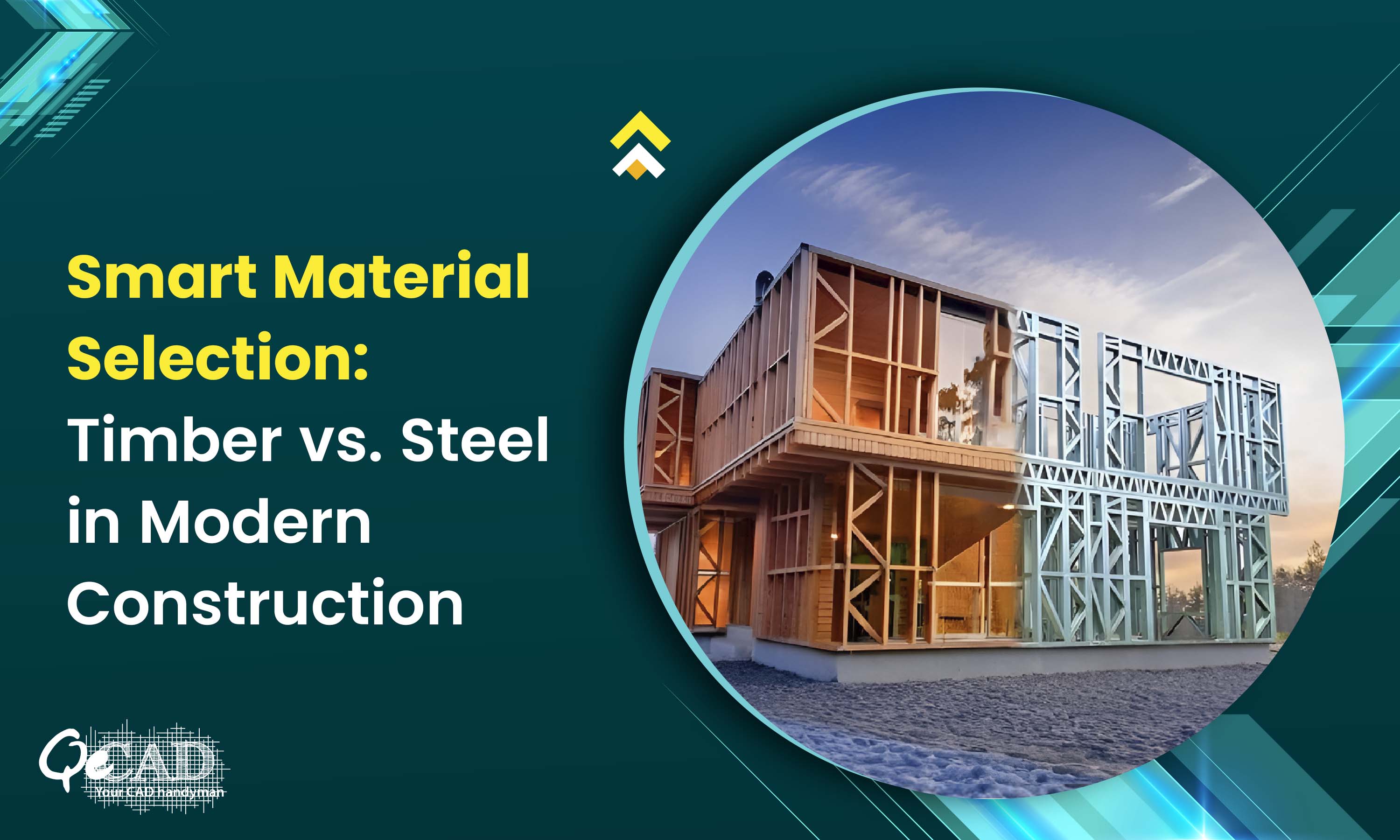
When it comes to structural materials, the debate between timber and steel has long divided architects, builders and developers. Each material brings its own strengths to the table but choosing the right one depends on various factors like sustainability, cost, strength, fire resistance as well as the design flexibility.
In this blog, we will break down the pros and cons of timber and steel to help you decide which material better suits your building project.
- Structural Strength & Durability
- Steel is undeniably strong. It has a high strength-to-weight ratio making it ideal for the high-rise buildings, large-span structures and even for the heavy industrial projects.
- Timber, especially engineered wood products like glulam or cross-laminated timber (CLT) also offers impressive strength but typically not as much as steel per volume.
Fact:
- Steel has a tensile strength of around 400-550 MPa while timber ranges from 40–80 MPa depending on the species and the treatment.
- CLT panels can support the loads of over 7 tons per square meter.
Winner: Steel – for the structural strength and even for the load-bearing capacity.
- Sustainability & Carbon Footprint
- Timber stands out as the leading choice for the sustainability. It is a renewable and biodegradable resource that, when harvested from the responsibly managed forests, can even achieve a carbon-negative footprint.
- Steel production consumes a significant amount of energy and contributes to approximately 7–9% of the global CO₂ emissions.
Fact:
- 1 m³ of wood stores approximately 0.9 tonnes of CO₂.
- Every ton of steel produced emits roughly 1.8 tons of CO₂.
Winner: Timber – for eco-friendliness and even for the carbon sequestration.
- Cost Efficiency
- Steel framing generally costs more upfront than timber but may offer savings in terms of time (due to prefabrication) and maintenance.
- Timber is cheaper in many regions and requires less specialized labor.
Fact:
- On an average timber framing costs $9–$12 per square foot while steel can range between $12–$20 per square foot.
- However, steel’s precision in prefabrication can cut construction time by up to 30%.
Winner: Timber – for lower material and labor costs especially in the residential construction.
- Fire Resistance
- Steel does not combust but loses its strength at the high temperatures (begins to fail around 600°C).
- Timber chars on the outside which can slow the internal burning especially with the thick or engineered wood.
Fact:
- Fire-protected steel structures can maintain integrity for 1–2 hours.
- Large timber sections can achieve 1-hour fire resistance with the minimal treatment.
Winner: Draw – both requires fire protection strategies but timber performs surprisingly well.
- Flexibility & Design
- Timber offers warmth and aesthetics and is easy to work with making it ideal for the homes, schools and even for the eco-projects.
- Steel enables longer spans and complex geometries supporting bold architectural designs.
Winner:
- Timber – for natural look and feel.
- Steel – for engineering marvels and even for the long-span structures.
- Longevity and Maintenance
- Steel is highly resistant to pests, rot as well as the Mold provided it is protected from the corrosion.
- Timber is vulnerable to the termites, moisture damage and decay without proper treatment.
Fact:
- Galvanized steel structures can last over 50 years with the minimal maintenance.
- Properly treated timber structures can also last 30–50 years but requires periodic upkeep.
Winner: Steel – for long-term durability and even for the low maintenance.
Final Verdict: Which Should You Choose?
| Factor | Winner |
| Structural Strength | Steel |
| Sustainability | Timber |
| Cost | Timber |
| Fire Resistance | Draw |
| Design Flexibility | Depends on Project |
| Longevity | Steel |
Choose Timber if:
- Sustainability and aesthetics are the top priorities.
- You are building a low to mid-rise structures.
- Cost and speed of the construction are the key factors.
Choose Steel if:
- You require longer spans or vertical builds (e.g., commercial, industrial).
- You need high structural strength with the low maintenance.
- Durability and precision are crucial.
Integrating Modern Solutions
No matter your material of choice, integrating technology into the planning phase is crucial. Services like the Structural BIM Services allows you to visualize, coordinate and even optimize your projects before the construction begins minimizing the risks and improving the accuracy. For those leaning towards the steel, leveraging Structural Steel Services can ensure precise fabrication, efficient installation and even compliance with the safety standards.
In Conclusion
There’s no universal solution in the timber versus steel debate—each material offers distinct advantages depending on the context. Your choice should align well with your project requirements, budget, environmental goals as well as the long-term vision. Whether it’s the warmth of wood or the precision of steel both materials have a powerful role to play in the modern construction.
